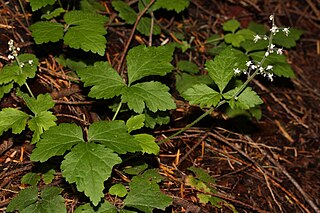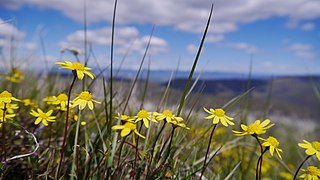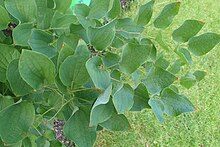
Phyllospadix scouleri, or Scouler's surfgrass, is a flowering marine plant in the family Zosteraceae. It is native to the coastline of western North America from the Alaskan panhandle to Baja California.

Tiarella trifoliata, the three-leaf foamflower, is a species of flowering plant in the family Saxifragaceae. The specific name trifoliata means "having three leaflets", a characteristic of two of the three recognized varieties. Also known as the laceflower or sugar-scoop, the species is found in shaded, moist woods in western North America.

Allium acuminatum, also known as the tapertip onion or Hooker's onion, is a species in the genus Allium native to North America.

Pyrrocoma is a genus of North American plants in the family Asteraceae. These wildflowers are sometimes known as goldenweeds.

Townsendia is a genus of North American plants in the tribe Astereae within the family Asteraceae.

Crocidium multicaule is a species of flowering plant in the daisy family known by the common name spring gold.

Grayia spinosa is a species of the genus Grayia in the subfamily Chenopodioideae of the flowering plant family Amaranthaceae, which is known by the common names hop sage and spiny hop sage. It is widely distributed across the Western United States, where it grows in a number of desert and mountain habitats.

Phyllospadix, commonly known as surfgrass, is a genus of seagrass, a flowering plant in the family Zosteraceae, described as a genus in 1840. Phyllospadix grows in marine waters along the coasts of the temperate North Pacific.

Crocidium is a small North American genus of plants in the daisy family. Crocidium is native to western North America: British Columbia Washington, Idaho, Oregon, and California.

Allium douglasii, the Douglas onion, is a plant species native to northeastern Oregon, eastern Washington, and northern Idaho. It grows in shallow soils at elevations of 400–1,300 m (1,300–4,300 ft).

Sagittaria graminea, the grassy arrowhead or grass-leaved arrowhead, is an aquatic plant species native to eastern North America.

Astragalus drummondii is a species of flowering plant in the legume family known by the common name Drummond's milkvetch. The botanist Thomas Drummond first identified the plant during his travels in North America from 1825 to 1835, the year of his death. Astragalus drummondii is one of many plants named after him. Upon the return of samples collected by Drummond to England, his findings were published in Sir William Hooker’s Flora Boreali-Americana in 1840.

Houstonia serpyllifolia, commonly called thymeleaf bluet, creeping bluet, mountain bluet, Appalachian bluet or Michaux's bluets is a species of plant in the coffee family (Rubiaceae). It is native to the eastern United States, where it is found in the central and southern Appalachian Mountains. It has been documented in the states of Pennsylvania, Maryland, West Virginia, western Virginia, North Carolina, South Carolina, Kentucky, Tennessee, Ohio, and northeastern Georgia.
Smilax illinoensis , the Illinois greenbrier, is a North American species of plants found only in the United States and Canada. It is native primarily to the Great Lakes Region with a few populations farther south in Missouri and in the Ohio Valley.
Smilax pumila, the sarsaparilla vine, is a North American species of plants native to the southeastern United States from eastern Texas to South Carolina.

Smilax tamnoides, common name bristly greenbrier, is a North American species of plants native to the United States and Canada. It is widespread from Ontario and New York State south to Texas and Florida.
Smilax walteri, common names coral greenbrier, red-berried greenbrier or red-berried bamboo, is a North American species of plants found only in the United States. It is native to coastal plains in the south-central, southeastern, and east-central parts of the country, from eastern Texas to New Jersey.

Erigeron grandiflorus is a North American species of flowering plant in the family Asteraceae known by the common names Rocky Mountain alpine fleabane and largeflower fleabane.
Erigeron radicatus is a North American species of flowering plant in the family Asteraceae known by the common names Hooker's fleabane and taproot fleabane The species grows in central Canada and parts of the north-central United States, primarily the northern Rocky Mountains and the Black Hills. It has been found in Idaho, Montana, Utah, Wyoming, Colorado, Nebraska, and South Dakota, with a few isolated populations reported from North Dakota.

Hypericum frondosum, the cedarglade St. Johnswort or golden St. John's wort, is a species of flowering plant in the St. John's wort family, Hypericaceae. It is native to the central and southeastern United States in dry, rocky habitats.















